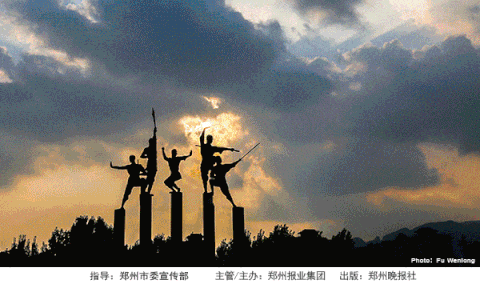西方的寓言故事英文(双语听读TheLegend)

803rd article第803期双语推文



NB: This may not be a word-for-word transcript.
On the Chinese lunar calendar, March 3rdis the day for worshiping the Yellow Emperor, also known as the Xuanyuan Emperor. Each year an ancestor worship ceremony is held on that day, bridging the Chinese nation's past, present and future. A five-thousand-year cultural foundation gives Chinese people great confidence in moving forward.
三月三,拜轩辕。一年一度的拜祖大典,就像“润物细无声”的春雨,把中华民族的过去、现在和未来紧紧地连在了一起。五千年的文脉,照亮了我们昂首阔步走向未来的道路。
Culture is essential for the long-term vitality of a nation and gives the people a sense of belonging. Cultural confidence represents a fundamental and profound force that sustains the development of a country and a nation. Chinese traditional culture conveys unique concepts, wisdom, bearing and charm, endowing Chinese people with deep confidence and pride.
文化是民族的血脉,是人民的精神家园。文化自信是更基本、更深层、更持久的力量。中华文化独一无二的理念、智慧、气度、神韵,增添了中国人民和中华民族内心深处的自信和自豪。
Zhengzhou, located in the heart of the Central Plains, is an important birthplace of Chinese civilization. As one of the eight ancient capitals, it enjoys a long history and profound culture.
郑州,地处中原腹地,史谓“天地之中”,是中华民族和华夏文明的重要发祥地、八大古都之一。“伸手一摸就是春秋文化,两脚一踩就是秦砖汉瓦”,其文化源远流长、底蕴深厚。
In order to help people better understand Chinese culture, we are going to tell stories about the Yellow Emperor, the legendary ancestor of Chinese people.
为了让更多人了解人文始祖黄帝的“丰功伟绩”,了解中国传统文化,我们今天为你讲述这些关于轩辕黄帝的小故事。

NB:
This may not be a word-for-word transcript.It is said that the Yellow Emperor wanted to choose someone talented to run the country in his stead as he grew older. Following a series of competitions, his two sons, Chang Yi and Xuan Xiao, were tied. He then personally made a final test for them.
相传黄帝年迈时,感觉自己精力不济,便想选贤能者接任。经过一系列选拔,他的两个儿子昌意和玄嚣脱颖而出。兄弟二人不相上下,黄帝在最后一轮考核中抛出了一道特殊题目。
The Emperor fetched two gourds which seemed normal but possessed magic making them bigger on the inside, each capable of holding enough water to flow 200 li. Giving the gourds to his sons, he instructed them to make water flow from Songshan Mountain to the Ying River, 300 li away from each other. He promised to name the winner as King.
他拿出两个葫芦给兄弟俩一人一个,说:“嵩山北坡到东边颍河300里路程,从嵩山开始放葫芦里的水,谁的水能流到颍河, 谁继帝位。不要小看这葫芦,里面浩瀚如海,开口即流,水流200里才会干涸。”
Time and again, the sons tried and failed. Each could only gather enough water to flow for 200 li. Eventually, they decided to work together by alternating, pouring their water every 100 li and combining their water to finish the final 200 li, completing the challenge together. The Yellow Emperor was filled with pride for his sons, and allowed them to govern the country together, with Xuan Xiao as the King and Chang Yi as his right hand.
两兄弟尝试无数次,均以失败告终,水流200里就干了。直到兄弟俩想出合二为一的办法,一起开始倒水才成功完成任务。黄帝很欣慰,决定让玄嚣继位,由昌意辅佐。
The water poured by Xuan Xiao was later called Zhenshui, the water left by Chang Yi was called Weishui, and the combined portion was named the Shuangji River.
从玄嚣葫芦里流出来的水后来就叫溱水,昌意葫芦里流出来的水叫洧水,它们汇流的部分叫双洎河,是淮河的支流。
Solidarity has long been a traditional virtue of the Chinese people.
自古以来,中华民族就讲究“兄弟同心”。
NB:
This may not be a word-for-word transcript.People in ancient times had to rely entirely on nature for survival, due to the shortage of necessities.
远古时期,生活资料贫乏,人们的生老病死大部分是靠“天意”。
One day, the Yellow Emperor was hunting in the mountain with his men. He found and shot a tiger in its back with his bow, but the tiger escaped despite its painful injury. Several days later, the tiger was found alive, eating a plant and licking its wound, which was basically healed.
一天,黄帝率部上山打虎。他拉弓射箭,正中虎背,老虎“嗷”的一声逃走了。几天后,众人发现那只受伤的老虎。奇怪的是,老虎正在吃一种草,边吃边舔背部的伤口,而伤口竟然基本愈合了。
The Emperor released the tiger and turned his attention towards the plant. He was inspired to bring it back and use it to heal injured people. As with the tiger, their wounds soon stopped bleeding.
黄帝放过了老虎,而把目光瞄准了那把“仙草”。他让大家把草采回,给有伤的人涂抹,果真,伤口很快就不流血了。
Seeing this, the Emperor ordered the physician Qi Bo to lead a team in researching plants and animals. After long periods of study, the group made steady progress, culminating in the earliest medical treatise in China. In memory of the Emperor, later generations named the earliest medical book after him - Huangdi Neijing – in combination with Five Elements Theory, Pulse Theory, Meridian Theory, and Etiology Theory, which formed the foundation of traditional Chinese medicine.
于是,黄帝命令医师岐伯带头研究花草树木、虫鱼鸟兽,经过长时间的观察、试验和积累,并将研究结果整理成册,随后便诞生了中国最早的医学著作。后世为了纪念黄帝的功德,综合了远古医术,糅合了“阴阳五行学说”“脉象学说”“经络学说”“病因学说”等学说建立中医学,著就中国最早的医学典籍,并定名为《黄帝内经》。
NB:
This may not be a word-for-word transcript.Since prehistoric times, people had no choice but to walk for travel. A visit to distant places needed several days of walking, which easily hurt the feet when carrying heavy things.
上古时期,人们生产生活都靠两条腿行走。如果去较远的地方就要走几天的路,如果再搬运一些沉重的东西,脚底就会被磨破。
One summer, the Emperor was working in the fields. A strong wind blew his hat off, which rolled away on the ground. Seeing the hat roll, he had a flash of inspiration. He chopped down a round cross section of a tree and put the stump sideways on the ground. When he pushed it forward, the stump rolled for several meters. He then fixed a cross-shaped wooden frame as an axle between two similar stumps to ensure they turned in the same direction, allowing it to carry things. Cang Jie, a minister of the Yellow Emperor, named the invention a "cart".
有一年夏天,黄帝在劳作时突然刮起一阵大风,将头上的圆草帽吹走了。掉在地上的草帽被风一吹,不断向前滚动,这给黄帝带来了灵感。砍一截树桩,放在地上用力往前一推,能滚出去一丈远。砍下两截树桩,再给中间扎个“十”字形的木架,推着更稳当,还可以滚动起来运东西。黄帝的大臣仓颉谏言,可以给这个东西起个名字,叫做“车”。
Vehicles in ancient China were called "xuanyuan", "xuan" refers to a cloth-covered frame, while "yuan" refers to the stick used to control the animals in front of "xuan". As the legendary inventor of the first traditional Chinese vehicle, the Yellow Emperor was thus called Xuanyuan.
古代装有帷幕的车叫“轩” ,车前面用来驾牲口的那根直木叫“辕”, “轩辕”合起来就是指古时候的车。由于传说车是黄帝发明的,所以人们就称黄帝为“轩辕氏”。《史记》中记载:“黄帝者,少典之子,姓公孙,名曰轩辕。”
In addition, the Emperor also created boats, becoming the pioneer of water transport in China. The invention of both land and water vehicles made people's lives much more convenient and efficient, greatly improving their productivity.
除了发明车,黄帝还懂得“凿木为舟”的道理,开启了中国最早的水上交通。黄帝造舟车不仅给人们的生活带来便捷,而且大大提高了生产力。真正实现了“遇河以舟载人,行路以车代步”。
NB:
This may not be a word-for-word transcript.After uniting the Yellow River Basin, the Yellow Emperor frequently held large-scale ritual ceremonies and celebrations, all of which required music. As no music was available at the time, he charged Ling Lun with creating a way to play music.
黄帝统一黄河流域之后,经常举办大型的祭祀、庆典活动,需要组建专业乐团,于是命伶伦寻找乐理的奥秘。
Ling Lun traveled from Daxia Mountain to Kunlun Mountain, where he finally found a kind of bamboo with a consistent outer thickness. He cut the bamboo into 12 wind instruments, and finally composed a twelve-note system by playing them in a way that imitated the voice of a phoenix.
伶伦从大夏山辗转到昆仑山,最后在山谷中,发现了一种壁厚均匀的竹子。他用竹子制造出12支管乐器,反复轮流吹奏,最终用竹管模仿凤凰的声音创制出了十二律音体系。
There are also records in Master Lü's Spring and Autumn Annals • The Ancient Music. It is said that Ling Lun, who was ordered by the Yellow Emperor to create music, discovered quality bamboo in the Kunlun Mountain valley and carved it into 12 pipe-shaped tools, by which he produced 12 tones that imitated the sounds of a phoenix.
《吕氏春秋 • 古乐》中记载:黄帝让伶伦制定声律,伶伦在嶰溪之谷截取良竹,以其声为黄钟之宫。又做十二筒,按凤凰的鸣叫声定为十二律。
"Ling Lun melody" and "delicate flute" were later used to describe people who had a talent for music. It is said that Ling Lun also made 12 bells and formed five traditional Chinese melodies by working together with Rong Jiang, to better share the beauty of music. Traditional chimes are said to be developed from these bells.
后人以“伶伦凤律”这一典故形容善知音律的人,也用以形容优美的音乐或精美的笛、箫。据说伶伦还和荣将合作铸造了12口钟,用来调和5种韵律,展现音乐的华美。后世的编钟,就是从这些钟演化而来的。
郑州市委宣传部、郑州报业集团联合出品
WhereZhengzhou工作室编辑制作
All rights reserved.
Feel free to forward to WeChat Moments.
转载请注明出处,欢迎转发到朋友圈
Chief Planner丨Shi Dadong
Managing Editor丨Xiong Vivi
Text丨Wang Yipin
Painter丨Zhang Xuening
Art Editor丨Wang Xiaoyu
Trainee Editor丨Xu Hanyu
Proofreader丨Russell(加拿大)
Voice丨Benjamin(英国)
,
免责声明:本文仅代表文章作者的个人观点,与本站无关。其原创性、真实性以及文中陈述文字和内容未经本站证实,对本文以及其中全部或者部分内容文字的真实性、完整性和原创性本站不作任何保证或承诺,请读者仅作参考,并自行核实相关内容。文章投诉邮箱:anhduc.ph@yahoo.com











